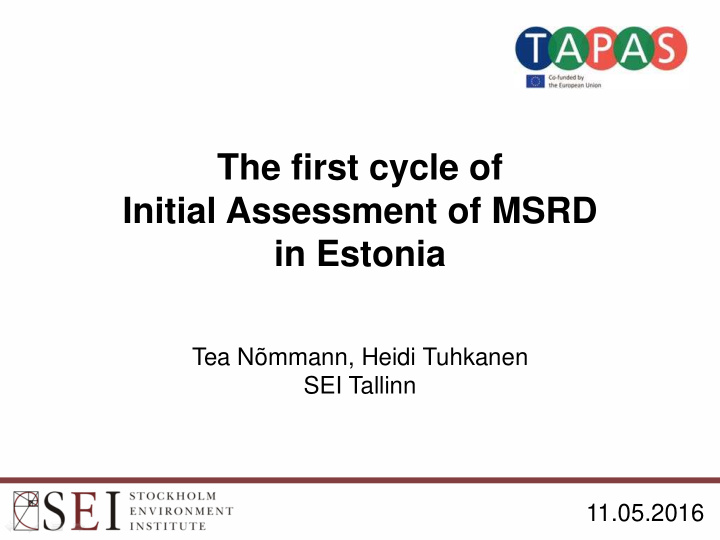



The first cycle of Initial Assessment of MSRD in Estonia Tea Nõmmann, Heidi Tuhkanen SEI Tallinn 11.05.2016
Initial Assessment in 2012 • Assessment of GES and ESA separately • ESA based on water account aproach due to … – Lacking studies on marine ecosystem services and time constraint for the IA – Covered all sectors from Maritime Policy and additional sectors based on ‘activities’ • BAU scenarios (trends) were described for all sectors • Cost of degradation / marine benefits – Eutrophication based on BalticSUN study – Significant oil pollution and invasive species based on rough benefit transfer esitmates • International cooperation via GES-REG project
Data sources for the ESA • ‘Maritime Policy 2012-2020’, which data was from the Estonian Tax Board & Business Register statistics . • Other sources of info included data from national accounts of the Statistical Office , which were not detailed enough to present the sea-related data adequately. • In some cases, regional statistics was helpful to estimate value added in the maritime sector. • Additionally, research studies and other available administrative databases were used. • For the sectors not covered in Maritime Policy 2012-2020 , a general description was presented using the best available data, including existing statistics and analyses.
Lessons learned • International collaboration important – EU ESA WS discussions and documents useful, but not fully utilised as MS’ at very different phases and time constraint – Baltic sea ESA experts’ platform ja methods needed (HELCOM) • Interministerial collaboration crutial – Many related and dependent policy processes • ESA to support the MSRD POM – but also Maritime Policy, MSP, WFD, Biodiversity Strategy (MAES) + BSAP • Valuation studies will be scarce also for the 2nd cycle • Use additional methods – multi criteria analysis … • Regional data - development work with Statistical Offices
Plans • Second cycle for IA – planning in initial stage, no concrete information yet • Should be developed further and more focused in scope on selected key themes of POM – Not to repeat extensive water use data revision as changes are most probably not significant, but focus on few env problems – Include also ecosystem services approach – Include social analysis – Build on POM and the linkages from impact-pressure- activity/sector-response (POM measures and real analysis on „alternatiive policy instruments“) – Further develop MCA that was used for POM CBA – Coordinated BAU scenarios (national, bilateral due shared waterbodies and BS regional) & consider alternative scenarious (positive, negative, etc)
Highlights • Economic benefits of water quality improvements are estimated. • The case study used is the Baltic Sea; benefits are estimated for Estonia. • Multiple stressors approach is used in a discrete choice experiment framework. • A new approach allowing for non-linear utility function is devised and implemented.
Abstract Many marine ecosystems are under increasing pressure from multiple stressors. In the Baltic Sea, these stressors include oil and chemical spills from shipping, nutrient run-off from land and the introduction of non- indigenous species. All of these pressures have been growing over recent years. Increasing pressures lead to reductions in environmental quality, which produce negative effects on human well-being. In this paper, the choice experiment method is used to estimate the benefits to people in Estonia resulting from reductions in pressure from multiple stressors in the Baltic Sea. The main results show that, firstly, respondents have a positive, statistically-significant willingness to pay to reduce each of the three stressors analysed. Secondly, the average willingness to pay for the improvement in the quality of all Estonian marine waters to achieve Good Environmental Status is around 65 euro per household per year, with a 95% confidence interval of 48–77 euro. Thirdly, the greatest share of value of this total economic benefit is derived from the willingness to pay for reductions in the risk of large scale oil and chemical spills.
Highlights • We analyze the trade-offs between wind parks and marine protected areas in Estonia. • Discrete choice experiment is used to estimate the relative welfare effects of 3 design options in two locations. • Latent class mixed logit model is estimated in willingness to pay space. • We find distinct preference heterogeneity both within and between latent classes of respondents. • On average, people prefer “eco” windfarms to conventional windfarms or marine protected areas.
Abstract The drive to increase renewable electricity production in many parts of Europe has led to an increasing concentration of new wind energy sites at sea. This results in a range of environmental impacts which should be taken into account in a benefit–cost analysis of such proposals. In this paper, we use choice modeling to investigate the relative gains and losses from siting new windfarms off the coast of Estonia, relative to the option of creating a new marine protected area. We find that, while respondents are generally opposed to converting marine shoals to conventional wind farms and prefer the establishment of marine protected areas instead, benefits from constructing ‘environmentally-friendly’ wind farms – an alternative program which is also considered by the government – are not statistically different with respect to consumers' welfare to those associated with creating a new marine protected area. Methodologically, the paper makes a contribution by showing the ability of the latent class mixed logit model to represent both within- and between-class preference heterogeneity, and thus its power to provide a more sophisticated representation of preference heterogeneity than stand-alone latent class or mixed logit approaches. The paper also presents the first use of the latent class mixed logit model in willingness-to-pay space for environmental goods
Recommend
More recommend